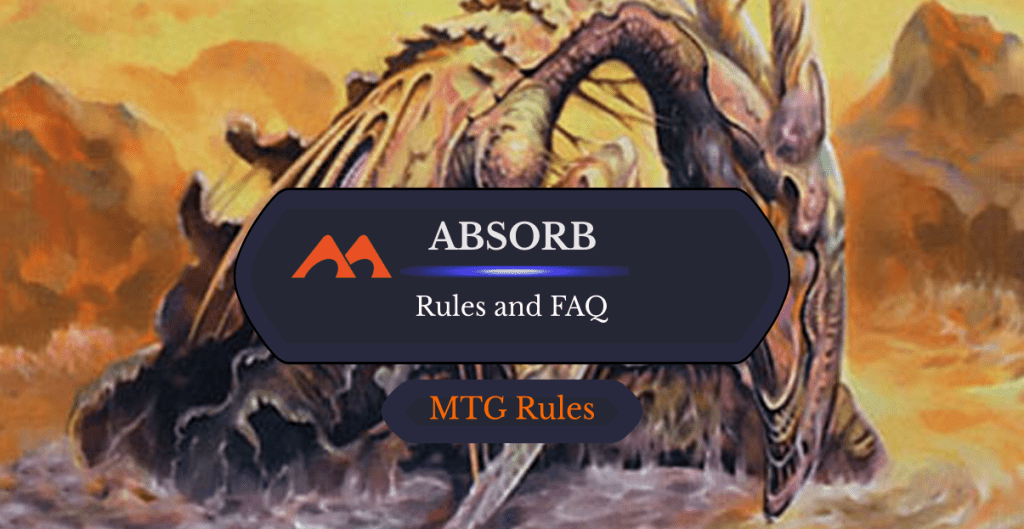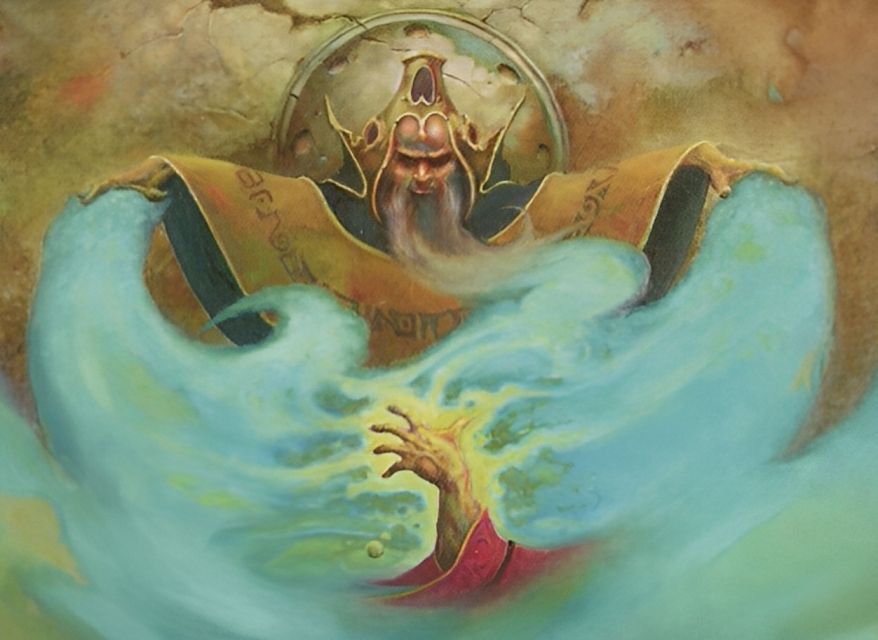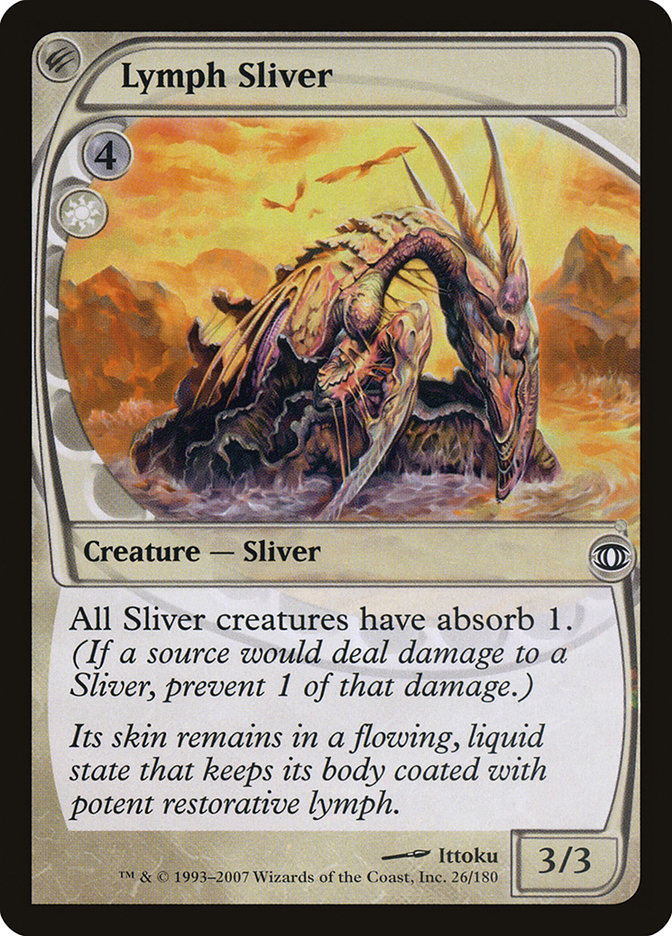Last updated on January 22, 2024

Lymph Sliver | Illustration by Ittoku
What do slivers from MTG have to do with Star Wars?
As it turns out, the use of armor!
Better said, they share one keyword that Magic designers had designed for the Star Wars trading card game that was later turned into a “futureshifted” sliver mechanic: absorb.
If you think that math is for blockers, absorb is guaranteed to make blockers' brains explode. Let's take a look at how this keyword ability works, how it fares against multiple sources of damage, and how the MTG designers came up with it.
How Does Absorb Work?

Absorb | Illustration by Andrew Goldhawk
Absorb is a static ability that prevents damage. It's written as “Absorb N”, with N being the amount of damage from each source that this ability can prevent.
Note that it applies to all sources of damage, be it combat damage, damage from spells or abilities, or any other source.
Absorb applies separately for each source of damage. If a sliver has “absorb 1” and multiple sources would deal damage to said sliver (like multiple blockers, or multiple spells on the stack), absorb prevents 1 damage from each of those sources.
The damage reduction works up to a minimum of zero: You can’t heal a creature by dealing “negative damage”!
Absorb also applies separately if the same source deals damage again at a later time. An Orcish Bowmasters can keep pinging a Lymph Sliver all day long across several turns, and the Lymph Sliver will shrug it off.
If a creature has several instances of absorb (for example, if you have several Lymph Slivers in play), each one acts separately. With two Lymph Slivers in play, each sliver would reduce incoming damage from a specific source by 2.
The History of Absorb in MTG
Slivers can brag about having the sole card in all of MTG with the absorb ability: Lymph Sliver. This keyword ability and its proud wielder debuted in the Future Sight expansion (from the Time Spiral block) in May 2007.
Future Sight had a cycle of five slivers with “futureshifted” keywords: abilities that Magic's R&D department wanted to experiment with and perhaps include in later sets depending on how well each of these keywords played, how well they were received, and how hard they’d be to add as a fully-fledged mechanic in an upcoming expansion.
There were a total of 81 “futureshifted” cards, all of them a sort of “pre-print” from a future set (as opposed to reprints from older sets). There was always the caveat that none of them was assured to ever return, which, in absorb's case, probably won’t happen.
“This mechanic was inspired by a mechanic we'd made for the Star Wars Trading Card Game called Armor,” wrote Magic's head designer Mark Rosewater in a series of articles published in August 2020. “It ended up being a little more powerful than we'd expected and slowed games down, so I'm not too optimistic of its return.”
In a post on his personal blog, Mark has rated absorb as an 8 on the Storm Scale, an informal scale from 1 to 10 that gauges how likely a mechanic is to return, with 10 being “Yeah, no, that's not gonna happen.”
Our lone absorber, Lymph Sliver, saw a reprint in Time Spiral Remastered, and that's the short life of absorb up to this day.
Is Absorb a Triggered Ability?
No. It's a static ability.
Does Absorb Stop -1/-1?
Nope. Reducing a creature's health is a different effect and doesn’t count as damage, so absorb doesn’t work against it.
Does Absorb Stop Multiple Points of Damage?
Yes, if they come from multiple sources. “Absorb 1” prevents 1 damage from each source.
What if You Block an Absorb Creature With Multiple 1/1s?
Lymph Sliver prevents 1 damage from each of those 1/1s and can deal 3 damage spread among them. The Lymph Sliver survives unscathed.
Gallery and List of Absorb Cards

Best Absorb Card

While slivers are legions, there's just one card in all Magic with absorb. So, yeah, it’s kind of easy to declare Lymph Sliver as MTG's absorb GOAT, no contest!
Our Lymphy friend is very budget-friendly. It costs less than a quarter nowadays, so it’s definitely cheap to try in your sliver deck if you think absorb is a keyword your hive-minded army would enjoy.
Wrap Up

Absorb Identity | Illustration by Matt Stewart
I’ll eagerly side with Mark Rosewater here – absorb is, I think, a pretty interesting mechanic, but it’s one that could prove too powerful if let loose (above all among slivers, that can stack it). For Limited formats, I have a hunch that an absorb-heavy set would lead to a lot of stalled boards with neither side being able to punch through as a lot of damage would be soaked.
Some other digital CCGs have pulled off this mechanic successfully; Legends of Runeterra, for example, has the tough keyword, which does exactly what “absorb 1” does. But in those other games, the damage doesn't wear off at the end of turn and therefore damage-reduction effects are not as powerful as in Magic.
I hope I helped you absorb the nuances of this particular keyword, and if this deep dive into unique mechanics is the type of article you'd like to see more of, please drop a comment below, or stop by the Draftsim Discord and let us know.
And may your slivers grow, share, and thrive!
Follow Draftsim for awesome articles and set updates:

Add Comment